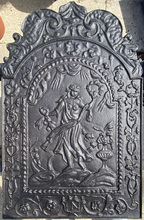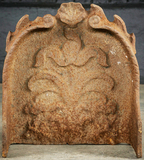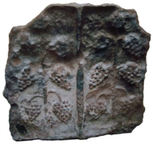-
1119
Description: Arched rectangular central panel with 'nutshell' over fillet edging; pictorial image of a partially clothed female figure, holding an upraised wreath in her left hand, standing on a ground, with a gadrooned vase containing flowers and leaves to the right, and above swagged drapery and sun rays; arched rectangular fillet border with descending leaves and flowers suspended from a wreath, top centre, and a wreath in each top corner; on top, mirrored sea monsters; bottom centre, logo formed of a pair of dividers in a cartouche between swirling fronds.
Notes: The figure is an allegorical representation of Agriculture, one of the Iconologia originally published by Cesare Ripa in 1613. A modern casting. Copies of this fireback were advertised in Burton Weir's (Rotherham) catalogue in the early-20th century.
Copies of this fireback are known.
- Decoration tags:
- 'Dutch' (shape)
- fillet (edging)
- whole carved pattern
- allegorical
- humans
- objects
Manufactured: in the late-17th to early-18th century in England.
Current location: not known.
- Attached to series:
- British 'Dutch' style firebacks
- Agriculture firebacks
-
1068
Description: Arched shape with forward-facing 'wings', which splay outwards towards the base, curved to follow the shape of the main panel; central panel with stylised tree decoration surmounted with a scallop shell between six 'leaves' (one damaged).
Notes: Nothing is known about the sources of free-standing firebacks or what prompted their production. Their form is similar and the predominant use of horticultural or arboreal decorative themes suggests production within a limited time frame. Only a very small number of such castings are known. This fireback casting was probably cast in an open box mould as the upcast (reverse) side of the casting shows evidence of being sand-treated. Depth 200mm.
- Decoration tags:
- free-standing (shape)
- none (edging)
- whole carved pattern
- plants
Manufactured: in the late-17th to early-18th century in England.
Current location: not known.
- Attached to series:
- Free-standing firebacks
-
847
Description: Originally rectangular; two identical panels, each with braid edging, a vine standard with six bunches of grapes and a cluster at the top.
Notes: One of an unusual series formed from separate panels arranged, in this instance, with repeated panel; fire-damaged, hence the distorted shape. Recovered after the fire at Nymans, Handcross, Sussex in 1947.
- Decoration tags:
- rectangular (shape)
- simulated rope (edging)
- carved pattern panels
- plants
Manufactured: in the late-16th century in the Weald area of England.
Current location: not known.
- Attached to series:
- Armada series


